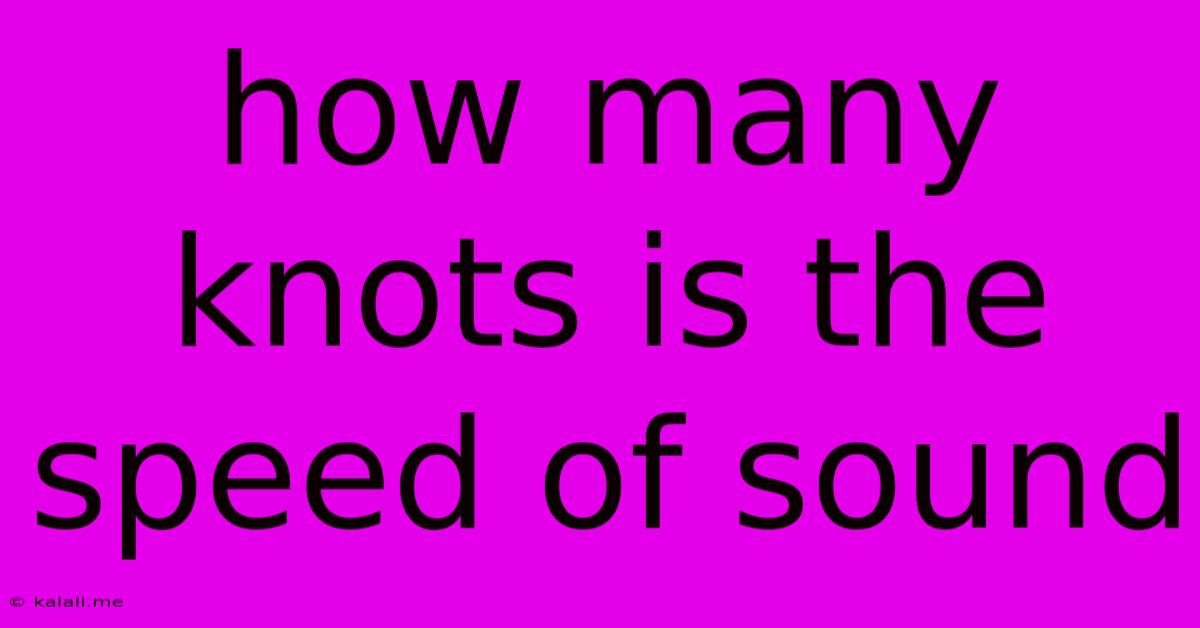How Many Knots Is The Speed Of Sound
Kalali
May 09, 2025 · 3 min read

Table of Contents
How Many Knots is the Speed of Sound? A Deep Dive into Units and Conversions
The speed of sound isn't typically measured in knots, a unit primarily used for marine and aviation speed. However, understanding the conversion between different units of speed, including meters per second (m/s), miles per hour (mph), and knots, is crucial for comprehending the relationship between sound's velocity and other forms of movement. This article will explain why knots aren't the standard for measuring the speed of sound and demonstrate how to convert the speed of sound from more common units into knots.
Why Knots Aren't Used for Sound Speed:
Knots are defined as nautical miles per hour. A nautical mile is approximately 1.15 statute miles (or land miles). This unit's origin lies in nautical navigation, relying on the Earth's curvature and the convenient length of one minute of latitude. Sound speed, conversely, is a physical constant dependent on the medium (air, water, solids) and temperature. While it’s possible to convert the speed of sound into knots, it's not a practical or common practice due to the mismatch in the typical applications of each unit. Scientists and engineers generally prefer units like meters per second (m/s) or feet per second (ft/s) for their precision and relevance to scientific calculations.
Calculating the Speed of Sound in Knots:
The speed of sound in dry air at 20°C (68°F) is approximately 343 meters per second (m/s). To convert this to knots, we need to follow these steps:
-
Meters per second to kilometers per hour: Multiply the speed in m/s by 3.6 (1000 meters/kilometer * 3600 seconds/hour). This gives us approximately 1234.8 kilometers per hour (km/h).
-
Kilometers per hour to nautical miles per hour (knots): Since 1 nautical mile is approximately 1.852 kilometers, divide the speed in km/h by 1.852.
Therefore, the speed of sound in dry air at 20°C is roughly 667 knots. However, keep in mind that this is a simplified calculation. The speed of sound changes depending on factors like temperature, humidity, and altitude. Therefore, this conversion provides a general approximation, not a precise scientific value.
Understanding the Implications:
While knowing the speed of sound in knots might seem like a niche calculation, understanding the conversions highlights the importance of using the right units for the context. For aviation and marine applications where knots are relevant, knowing the speed of sound in knots could be useful in calculations related to sonic booms or the effects of sound propagation over long distances.
Factors Affecting Speed of Sound and Conversions:
It's crucial to remember that the speed of sound varies significantly depending on various factors:
- Temperature: Higher temperatures lead to faster sound speeds.
- Humidity: Higher humidity slightly increases the speed of sound.
- Altitude: Sound travels slower at higher altitudes due to lower air density.
- Medium: Sound travels much faster in water and solids than in air.
These variations mean any conversion to knots will only be accurate for the specific conditions used in the initial speed measurement. Always account for these factors for the most accurate calculations.
In conclusion, while the speed of sound isn't commonly expressed in knots, the conversion process allows for a better understanding of the different units of speed and their applications. This knowledge is beneficial across multiple scientific and engineering disciplines, emphasizing the importance of unit conversion and the contextual relevance of choosing the right unit for your specific calculations.
Latest Posts
Latest Posts
-
Words That Start With Y In Science
Jul 12, 2025
-
Prevent An Expressway Emergency By Merging Without
Jul 12, 2025
-
How Many Grams Of Sugar In A Pound
Jul 12, 2025
-
7am To 11am Is How Many Hours
Jul 12, 2025
-
If Your 35 What Year Was You Born
Jul 12, 2025
Related Post
Thank you for visiting our website which covers about How Many Knots Is The Speed Of Sound . We hope the information provided has been useful to you. Feel free to contact us if you have any questions or need further assistance. See you next time and don't miss to bookmark.